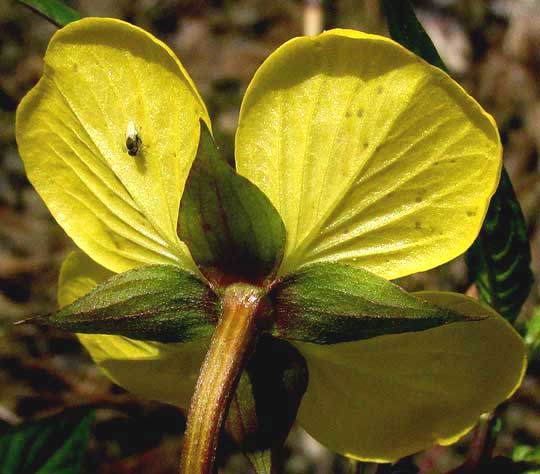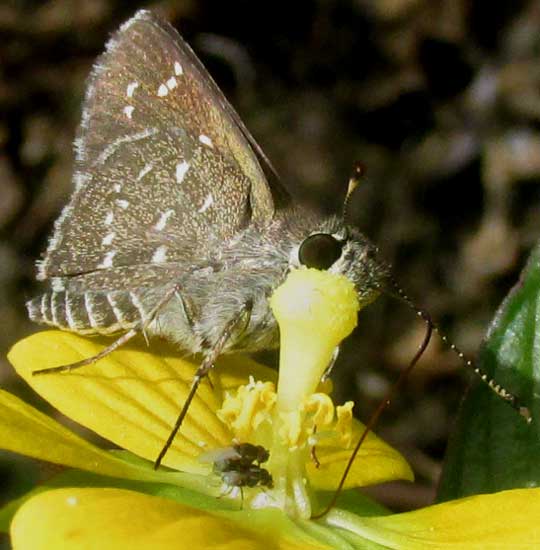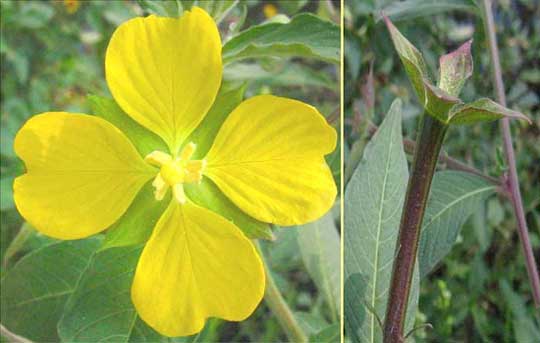Excerpts from Jim Conrad's
Naturalist Newsletter
from the July 12, 2015 Newsletter issued from Río Lagartos, on the Yucatan Peninsula's northern coast (~N21.60°, ~W88.16°), Yucatán state, MÉXICO
MEXICAN PRIMROSE-WILLOW
In mud and shallow water at the edges of ponds, lagoons and in ditch bottoms, nowadays you find knee-high herbs with pink stems and willow-like leaves, and bearing fair-sized, brightly yellow flowers, each blossom bearing four petals, as shown below:

Up close, the flowers display a very distinctive architecture, as shown below:

There you see stamens clustered about the base of a thick style topped with an oversized, spherical stigma. Bases of the four petals -- and four is a somewhat unusual petal number -- are widely separated from one another, the stamens rising up between them. In the above picture you don't see an ovary because in this family, the Evening Primrose Family or Onagraceae, ovaries are " inferior." That means that the ovaries are located below the petals and male parts. Below, you can see the long, reddish, stem-like ovary below our flower, with four green sepals below and between the petals:

While I was photographing the flowers a Toltec Roadside-Skipper, Amblyscirtes tolteca, suddenly landed on one, poked its straw-like proboscis around the style and began taking nectar from nectaries between the stamen bases -- while two mating flies supped on the other side -- as seen below:

In the US often wildflowers in this wildflower's genus, the genus Ludwigia, are called seedboxes because the ovaries mature into boxy capsules filled with tiny, hard seeds, which spill out when mature. They're also called primrose willows because their leaves are so willow-like. Our plant is the Mexican Primrose-Willow, LUDWIGIA OCTOVALVIS, apparently native to the tropical Americas, but found worldwide in tropics and subtropics, including the US Deep South. With such an extensive distribution, the "Mexican" part of the common name is appropriate only from the US point of view. When you think about the plant's tiny seeds mixed in mud that's likely to stick to the feet of wandering and migrating birds, the species' worldwide distribution becomes understandable.
The online Atlas de las Plantas de la Medicina Tradicional Mexicana reports that in parts of Mexico the plant is used for various skin diseases, including mange on animals. Also a tea made of brewing the plant in hot water is diuretic -- makes you pee.
From Jim Conrad's Naturalist Newsletter of March 10, 2008 Newsletter written in the community of 28 de Junio, in the Central Valley 8 kms west of Pujiltic, elev. ~700m (2300ft), ~N16.331°, ~W92.472°; southeastern Chiapas state, MÉXICO
WATER-PRIMROSE
In mud alongside our irrigation canals right now a knee-high, somewhat weedy herb is issuing two-inch wide, four-petaled, yellow blossoms such as those seen below.

Wildflower fanciers up North should recognize this as a species of Water-primrose, or Seedbox, genus LUDWIGIA, of the Evening Primrose Family. At the right in the image you can see the plant's long, slender, immature fruit topped with four persistent sepals. When the fruit splits, large numbers of tiny seeds will pour out. This species appers to be the Mexican Primrose Willow, LUDWIGIA OCTOVALVIS.
The name Water-primrose is appropriate because this species' flowers and fruits are very similar to those produced by evening primroses of the genus Oenothera, of the same family. The most obvious differences between the genus Ludwigia and Oenothera are that in Ludwigia the sepals arise from directly atop the fruit, nicely shown in the photo, while among evening primroses, genus Oenothera, sepals arise from a kind of collar, or calyx tube, crowning the ovary. Also, Ludwigia sepals usually are persistent, while those of Oenothera are deciduous.
Sometimes Ludwigia fruits are very short and squarish, at least squared immediately beneath the four sepals. In late fall if your leg brushes against a mature Ludwigia of this type hundreds of sandgrain-like seeds will spill from dozens of small, boxlike, capsular fruits, and the plant almost names itself, "seedbox." The neat word for the shape a fruit that's roundish on one end but squarrish on the other is "obpyramidal."
I associate Ludwigia's bright yellow flowers with hot, humid summers and, since they're usually in swampy places, mosquitoes. When I saw our Ludwigias flowering here I knew I needed to mention them, just to evoke that hot, sweaty, mosquitoey association for Northern, winter-bound readers